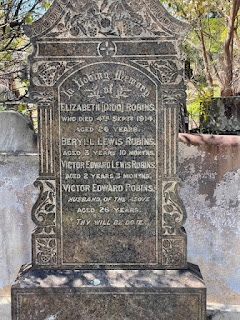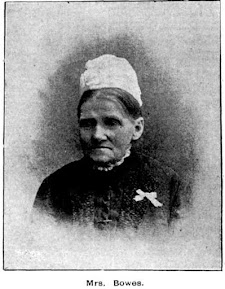Sad tales of troubled minds
There are many murderers and victims buried in
Rookwood. Most of the murderers lie in areas that have been allowed to return
to nature, but many are lying in amongst their victims such as Stuart Briggs who
I mentioned in this blog a few weeks ago. His poor unfortunate victim lies but
a few plots away.
But what of the plots where both the murderer and
the victim (or victims) are all buried together. I often wonder what nocturnal
activity abounds in the area.... Today's blog highlights two of these tragic
tales.
VICTOR EDWARD ROBINS
Victor was born in October 1887 to John and
Margaret Robins, the second last of their seven children. Victor was a part
owner of the family run shoe manufacturing business which operated under the
name of J Robins in Leichardt, commencing operations in 1911. He was known to
be a of a quiet disposition.
It seems that from August 1914, Victor showed
signs of depression and odd behaviour so much so that his wife Elizabeth
confided to her sister Nellie that she feared for her life. She told Nellie
that Victor would look at her in a peculiar manner and would ask her if she was
frightened of dying. Nellie advised her to take the children and go to her
mother’s place, but she declined as she thought that with the presence of
Victor's younger brother, Frederick, who had recently moved into the house with
them, that the family would be safe. She was also concerned that Victor may
harm himself and she couldn't bear the guilt.
By late August, Victor was showing further signs
of depression and had become silent. He visited his Doctor on 1st September due
to a nasal problem and possible influenza but, more alarmingly, was advised
that a bone in his nose was stopping fluid coming from his head. From that date
Victor took leave from work.
About 7am on 4th September, Frederick left the
house for work, leaving Elizabeth preparing breakfast for the family.
Later that day, Robert Brebuer, the local greengrocer, was making his regular visit to the house in Strathfield and when he
went to move away from the back door where he had had no reply, his eyes fell
on the bloodstained body of Victor in the laundry who was lying there with a
razor in his hand.
Robert alerted the Police and upon entering the
house the bodies of Elizabeth and their children, Victor, junior and Beryll,
were found in the bathroom. Elizabeth had her throat cut and the children had
severe bruising on their necks.
At the subsequent inquest it was decreed that
Victor Robins had strangled both his children, cut his wife's throat with a
razor and then turned it upon himself.
No finite reason was found as to why Victor had
taken this action, but it was noted that having shown signs of depression in the
weeks before the incident and with his unusual illness, perhaps a form of
encephalitis, it may have led to him being "temporarily insane".
The Robins family lie together in a plot in
Section 5 near the Little Serpentine canal, in the old Anglican area.
The Robins family headstone - photo author's own
Shocking as that murder suicide was, there is one
other I wish to share
DR JOHN MARK ANTHONY PALING
John (or Jan Marie Antoine Paling as he was
christened) was the only son and child of Nicholas Henrick Paling, originally
from the Netherlands, and Sarah Kezia Payton (her second name of Kezia in
recognition of her older sister who died as an infant). John's father was a
well-known man in business circles in his role as Consul for the Netherlands.
John was brought up in privileged circumstances
and was a bright student but whilst studying to be a doctor, his father became
mentally ill. Rather than suffer the indignity of being confined to an Asylum,
he was nursed by his wife at home. John's mother devoted her life to making a
success of her son in the medical field whilst juggling the strain of looking
after a troubled man. Eventually Nicholas was taken to Gladesville Asylum.
At the time of his father's removal from the
home, John was studying for his final examination in Medicine at Sydney
University. It was believed that there was to be a great contest between John
and his University rival John Hunter. No doubt being distracted by personal
affairs saw Hunter decisively beat John.
John was not content with being a General Practitioner
or a Surgeon but wanted to continue in original research work into diseases of
the mind. To obtain more information in this field he undertook a trip to
England for several months.
Upon his return and just before he sat for
further Degrees, his mother showed signs of mental incapacity. Immediately he
abandoned his studies and devoted himself to caring for his mother, like she
had been to his father, in their home in Dulwich Hill.
Mrs Paling never left the premises again and was
in a decreasing mental state for at least four years, John alone administering to
all her needs.
When his rival and good friend Professor John
Hunter suddenly died, he was devastated and took upon himself the task of
writing his dear friend's biography with another of his friends who went
through university with them both. His friend Dr Hull, pressed John to send his
mother to an Asylum as he believed her presence in the home was having a
detrimental effect on John's own mental health.
It was suggested that Paling become an
"honorary" at one of the large Sydney Hospitals in order to allow him
due recognition for his genius and to get him away from the toxic atmosphere of
the home; but John was not interested. Sometime later he handed Hull all the
papers about John Hunter and told him to look after them. John was advised soon
after to sell his practice and take a holiday, but he wasn't interested in this
course of action.
On Sunday 12th December 1926, John and his mother
were found dead at their Dulwich Hill home. It appears that prussic acid
(cyanide) had been administered to Sarah with John Paling then administering a
fatal dose upon himself. Mrs Paling was lying in bed with John on the floor, a
table nearby had three bottles of prussic acid, two syringes and four empty
morphia vials. Two broken needles were found in Mrs Paling's arm. It appeared
the act was well planned.
Dr Hull admitted that he had been told on a
number of occasions that Paling would "end everything" and had
finally carried out that threat. Dr Paling had a genuine fear of being an
inmate of a mental institution and had told many that he would never be taken
to a mental hospital.
Nicholas Paling remained in mental institutions
until his death in Goulburn in 1936.
John Paling and his mother Sarah lie together in
a plot near to the Robins' in the old Anglican area of the Cemetery.
Two very tragic deaths. The mind is a very intricate
but delicate part of us all. Mental illness was not as easily recognized then
as it is now. Thank goodness a mental condition is more easily accepted in society and
treatable today. It can only improve.
May they all rest in peace,
There are a number of Trove newspaper references
to both of these dreadful events, upon which I have based my blog.
Please feel free to comment below or post a
comment at the Group facebook page under
rookwoodcemeterydiscoveries
or simply email me at
lorainepunch@gmail.com





Comments
Post a Comment